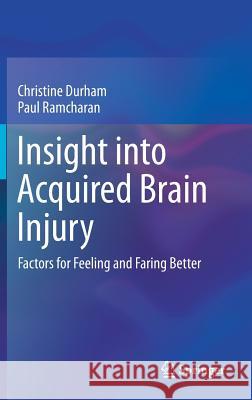Insight Into Acquired Brain Injury: Factors for Feeling and Faring Better » książka



Insight Into Acquired Brain Injury: Factors for Feeling and Faring Better
ISBN-13: 9789811056659 / Angielski / Twarda / 2017 / 219 str.
Insight Into Acquired Brain Injury: Factors for Feeling and Faring Better
ISBN-13: 9789811056659 / Angielski / Twarda / 2017 / 219 str.
(netto: 575,06 VAT: 5%)
Najniższa cena z 30 dni: 578,30
ok. 22 dni roboczych
Dostawa w 2026 r.
Darmowa dostawa!
This book offers an empowering approach to working with people with an acquired brain injury (ABI) based upon the views and perspectives of people with ABI themselves.
"This book discusses the various models of brain injury rehabilitation and their benefits and drawbacks. The book also introduces one of the lead author's tool for processing the challenges of ABI recovery ... . It is written for professionals caring for brain injury survivors and their families. The book does well in illustrating patients' perceptions of the rehabilitation process and, more importantly, how they often perceive the actions and motives of rehabilitation clinicians." (Kevin Franzese, Doody's Book Reviews, February, 2018)
Chapter 1. Acquired Brain Injury.-
Chapter 2. Understanding the Assumptions of Major Models of Disability Theory.-
Chapter 3. Body-Object knowledge and its Relevance.-
Chapter 4. The Body-Subject Perspective of ABI. A Literature Review of Qualitative Studies.-
Chapter 5.Reflection, Understanding and Insight from the Educational/Learning Perspective.-
Chapter 6. Capturing Insights.-
Chapter 7. Understanding What negatively affects the lifeworld of People with ABI.-
Chapter 8. Factors that positively affect the Lifeworld of the Person with ABI: 'Keys' for Change.-Chapter 9. Illuminating 'Blind Spots' for the Health Service Providers.-
Chapter 10. Parting Thoughts: Finding a Balance.
Christine Durham is the author of Doing Up Buttons (Penguin Books) and Unlocking my Brain: Through the Labyrinth of Acquired Brain Injury (Ventura Press). Over two decades ago she suffered extensive injuries including an acquired brain injury in a horrific car accident. After learning how to talk, walk and think again, Christine returned to teaching with new insights into how children learn and engage with ideas. She has now completed a PhD and speaks to a variety of audiences in Australia and overseas about both education and her experience of acquired brain injury, including community organizations, leadership and rehabilitation groups, health professionals, universities, school faculty and parents. Christine’s work has appeared in magazines and newspapers and her book, Chasing Ideas (Finch Publishing), has been translated into Chinese, Korean and Arabic. Christine was the Victorian Senior Australian of the Year 2014 and was the Brainlink Women of Achievement 2012.
Paul Ramcharan is an associate professor at the Centre for Applied Social Research at RMIT University and is co-director of research at the Future Social Service Institute . He has been involved in research with and for people with disabilities for over 25 years with a strong focus on advocacy and empowerment. Since arriving in Australia his work has encompassed these themes alongside human rights and disability, the reduction of restrictive practices and choice-making. Paul has occupied a number of national positions as a research manager in the UK. With a colleague he coordinated a thirteen-project national research initiative designed to support implementation of Valuing People, an English white paper designed to improve the lives of people with intellectual disabilities. He has been on several research panels including for the Big Lottery Fund and the Social Care Institute of Excellence in the UK. In his role with the Future Social Service Institute Paul is seeking to develop co-design into research processes, to establish empowering practice through both research and action.This book offers an empowering approach to working with people with an acquired brain injury (ABI) based upon the views and perspectives of people with ABI themselves. Drawing upon Christine Durham's own ABI experience and Paul Ramcharan’s engagement in disability research over a quarter of a century, this volume gives voice to 36 participants with ABI, as well as carers and other professionals from both urban and rural areas. This unique perspective provides a long-needed, empathic alternative to the deficit-based model of ABI that dominates medical literature and existing rehabilitation models. In Insight into Acquired Brain Injury, the authors use educational and learning principles together with Durham’s extensive archive of experiential data to offer a reframing of the nature and experience of ABI and relevant a set of practical, real-world tools for practitioners. These ready-to-adopt-and-adapt scripts, guided interviews, research checklists, thinking tools and other innovative techniques are designed to engage with people and colleagues about brain injury as a means of supporting them to feel and fare better. With compassion and first-hand awareness, Insight into Acquired Brain Injury provides a much-needed perspective that deepens current understanding and translates the complicated life-worlds of people living with ABI in order to motivate, empower and increase their participation.
1997-2025 DolnySlask.com Agencja Internetowa
KrainaKsiazek.PL - Księgarnia Internetowa









